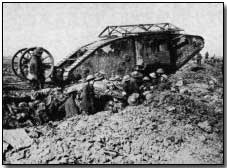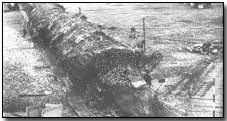Battles - The Battle of Flers-Courcelette, 1916
 A subsidiary attack of the Somme Offensive,
the Battle of Flers-Courcelette was notable for the introduction of
tanks.
The attack was launched across a 12 km front from
Rawlinson's Fourth Army salient on 15 September.
Twelve divisions were employed, along with all the tanks the British army possessed: 49.
A subsidiary attack of the Somme Offensive,
the Battle of Flers-Courcelette was notable for the introduction of
tanks.
The attack was launched across a 12 km front from
Rawlinson's Fourth Army salient on 15 September.
Twelve divisions were employed, along with all the tanks the British army possessed: 49.
Sir Douglas Haig, the British Commander-in-Chief, had wanted many more tanks in readiness for the full launch of the Somme Offensive on 1 July, but nevertheless determined to proceed with the Flers-Courcelette attack with this reduced number - a somewhat controversial decision, it having been argued that the tanks would be of little practical use in such small numbers. Sir Winston Churchill, who had championed the development of the tank, complained "my poor 'land battleships' have been let off prematurely on a petty scale".
These early tanks proved notoriously unreliable during testing and application. Weighing approximately 28 tons, they could only move forward at a snails pace, a half mile per hour. They were impervious to small arms fire, and to a lesser extent machine gun fire (metal chips would fly inside the tank, resulting in the issue of chain-mail visors to the operators, uncomfortable and seldom worn). However shell fire could (and did) easily destroy a tank.
Navigation and visibility were poor - the latter leading on more than one occasion to the tank directing friendly fire from its guns onto its own forces. Radio communication was not available until late in the war: carrier pigeons were used instead.
 The
attack was preceded by an artillery-bombardment designed to leave unshelled lanes open for the advance of the new mobile weapon.
The
attack was preceded by an artillery-bombardment designed to leave unshelled lanes open for the advance of the new mobile weapon.
Accordingly, on 11 September the 49 tanks began to move slowly into position in the line. As a measure of their fundamental unreliability, 17 tanks were unable to make it as far as the front line. Of the 22 that did, a further 7 failed to work at zero hour. Thus 15 of the 49 tanks rolled slowly into No Man's Land with the start of the attack on 15 September.
Despite this, the launch of the tanks produced devastating effects upon German morale - at least locally, and initially. On a wider front their effectiveness was limited, given their scarcity allied with their inherent unreliability. The German High Command's initial reaction was that the tank could be defeated rather than imitated.
However, the British Expeditionary Force (BEF), together with the Canadian Corps, made initial gains of some 2 km within the first three days, something of an achievement at the time, and particularly during the Battle of the Somme. Led by tanks the villages of Martinpuich, Flers and Courcelette fell to the Allies, as did the much sought-after High Wood.
Nevertheless, a combination of poor weather and extensive German reinforcements halted the British and Canadian advance on 17 September; the Allies had again suffered heavy casualties, including Raymond Asquith, the son of the British Prime Minister Herbert Asquith. The attack was called off on 22 September.
The use of tanks had by no means led to any anticipated breakthrough, but they nonetheless impressed Haig, who requested that 1,000 more be constructed.
Photograph courtesy of Photos of the Great War website
The Western Front Today: Tank Corps Memorial
The Western Front Today: Courcelette Canadian Memorial
The Western Front Today: 41st Division Memorial, Flers
A "Grand Slam" was British slang for an impending attack or battle.
- Did you know?
